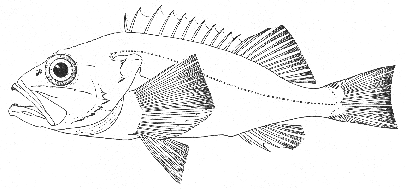Black-bellied rosefish Helicolenus dactylopterus (De la Roche) 1809
RED BREAM; BLUE MOUTH
[Jordan and Evermann, 1896-1900, p. 1837 as (H. dactylopterus (De la Roche) and H. maderensis Goode and Bean 1895).[46]]

Figure 224.—Black-bellied rosefish (Helicolenus dactylopterus), off southern New England. Drawing by Louella E. Cable.
Description—
This species resembles the common rosefish closely in its general form and in the outline and arrangement of its fins. But the lower 7 to 9 rays of its pectoral fins are free from the fin membrane along the outer half to one-third of their length, and the upper margin of the pectorals is [page 438] nearly straight, which gives the fins an aspect noticeably different from that of the rosefish. The space between the eyes (flat in the rosefish) is grooved in the black-bellied species; there are only 12 spines in the spiny portion of its dorsal fin (14 or 15 in the rosefish) and only 5 or 6 soft anal rays instead of 7 (in addition to 3 stiff spines).
Its caudal fin is relatively larger than that of the rosefish; its eyes closer together, the distance between them being less than one-half as great as the diameter of the eye (about two-thirds to three-quarters in the rosefish); the maximum depth of its body is somewhat less than the distance from tip of upper jaw to upper corner of gill cover; and its scales are larger relatively.[47] A more important difference anatomically is that the red bream has only 24 or 25 vertebrae, the rosefish 31.
Color—
More or less vivid reddish or pale pinkish, usually with some brown and green along the back and with irregular cross bands of darker or brighter scarlet on some specimens; the upper part of the sides marked with a sparse pattern of narrow, dusky vemiculations, roughly following the edges of the scales; and each gill cover generally has a leaden or dusky patch caused by the black inner surface shining through the bone. The lower surface is without dark markings. All the fins are pinkish, the spiny part of the dorsal mottled with white, and the soft portion of the dorsal, the ventrals, and the anal edged with white. The lining of the belly cavity is black, hence one of its common names.
Size—
Maximum length about 15 inches.
Habits—
Catch records show that the blackbellied rosefish sometimes are in the mid-depths, sometimes on bottom or close to it. Beyond this nothing is known of their daily life. Neither is it known definitely whether their eggs are hatched within the oviducts of the mother, as in the rosefish (p. 433), or whether they are set free in the water, like those of most fishes.[48]
General range—
Known from the eastern slope of Georges Bank westward and southward to Florida in depths of 68 to 373 fathoms in the western Atlantic; from Norway to the Canaries in the eastern; also in the Mediterranean.
Occurrence in the Gulf of Maine—
This fish must be generally distributed over the outer part of the continental shelf and along the upper part of the continental slope as far east as the general offing of Nantucket, for it has been reported from 27 stations between longitude 72° and a few miles east of longitude 70°,[49] including one catch of more than 100 of them, 4¾ to 11 inches long, in one haul, by the Albatross III.[50] One about 13 inches long was trawled on the eastern edge of Georges Bank, at 175 fathoms, October 6, 1929.[51] Subsequent records that fall within the limits set here for the Gulf of Maine, are of 24 fish, 4-10 inches long, trawled at 5 stations south of Nantucket, at 68-240 fathoms, by the Albatross III, May 11-18, 1950; of one brought in by the trawler Red Jacket from the northern slope of Georges Bank, from 120 fathoms, in 1949;[52] and of a catch of about 300 pounds of them, made in the southeastern part of the basin of the Gulf, at 120-140 fathoms, July 24, 1948.[53]
This last catch is especially interesting, for it shows that schools of black-bellied rosefish may occasionally come in via the deep channel between Georges and Browns Banks. But they have never been reported in the inner parts of the Gulf, nor are they to be expected there unless as strays from offshore.
[46] We have examined some of Goode and Bean's specimens and agree with Holt and Byrne (Fisheries, Ireland, Sci. Inv. (1906), v. 1908) that the so-called H. maderensis is identical with H. dactylopterus
[47] About 42-48 oblique rows of scales from upper corner of gill opening to base of caudal fin in Helicolenus, 60-70 in Sebastes.
[48] Ehrenbamn (Nordisches Plankton, Zool., vol. 1, 1905, p. 51) thought it probable that this is an egg-laying species, and Tåning (Journal du Conseil, Conseil Internat. Explor. de la Mer, vol. 16, 1949, p. 86) so characteristizes it. But its ripe eggs have not been seen, so far as we know.
[49] For list of stations, with depths, up to 1895, see Goode and Bean, Smithsonian Contrib. Knowl., vol. 30, 1895, pp. 251-252, as Helicolenus maderensis; Albatross III, also, trawled one or more specimens at nine stations off southern New England in May 1950.
[50] Latitude 39° 42' N., longitude 71° 57' W., 145-210 fathoms, May 12, 1950.
[51] This specimen, reported by Firth (Bull. 61, Boston Soc. Nat. Hist., 1931, p. 13) is in the Museum of Comparative Zoology.
[52] Specimen in Museum of Comparative Zoology.
[53] Taken by the schooner Alice M. Doughty, Capt. Manual Silva. Six of these specimens are in the Museum of Comparative Zoology.